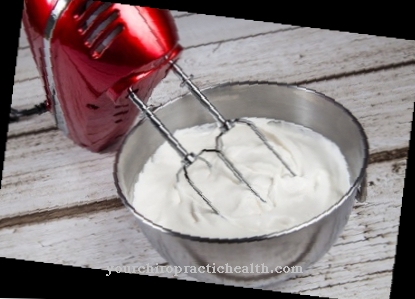The oil obtained from safflower has been used as a food and medicine for thousands of years. Already in ancient times Safflower oil known for its health-promoting ingredients. Today, due to its fatty acid composition, it is one of the healthiest vegetable oils that are used in the kitchen.
What you should know about safflower oil

Safflower oil is obtained from the seeds of the real safflower (safflower plant) by cold pressing. Another common name for the oil is Safflower oil.
Heated, refined oils are also available, but they have less beneficial properties. The Latin name of safflower is Carthamus tinctorius. The medicinal and useful plant already used in antiquity contains unsaturated fatty acids and numerous ingredients that are relevant for a healthy diet. Safflower oil is also used successfully in medicine against various ailments.
The safflower is common all over the world, it is found in North Africa, East Asia and North America. Today, Egypt is one of the main growing areas for the plant. The plant is traditionally not only grown for oil production, because the herb of the plant is a natural dye for textiles. However, its importance as a dye plant has declined sharply since chemical dyes existed.
The oil from the seeds of the safflower plant is light and clear to light yellow depending on the degree of filtration. It has a mild to slightly tart taste that is unobtrusive and most people find it pleasant. Accordingly, it can be used in many ways in the kitchen for salads, sauces or for stewing.
Safflower oil differs from other vegetable oils mainly in its high linoleic acid content. With an average linoleic acid content of 78-81%, the oil is the front runner among all vegetable fats. For comparison, sunflower oil contains between 20 and 75%, olive oil only 3-20%. The doubly unsaturated linoleic acid is particularly valuable for human nutrition. For this reason, safflower oil is offered not only as an edible oil for daily nutrition, but also in high quality as a dietary supplement and natural medicine.
The unsaturated fatty acids in thistle seeds can even be helpful in losing weight because they are better metabolized in the body than saturated fats. Compared to hydrogenated or animal fats, they are completely absorbed and not converted into storage fat. If you want to lose weight, you benefit from replacing saturated fats in recipes with safflower oil.
The oil is also used in cosmetics, for example to care for blemished skin or as a basis for various natural cosmetic products. The oil has a moisturizing effect and supports the skin's natural protective barrier. Thistle extracts are said to have a cell-renewing effect, which is why they are used as a natural anti-aging ingredient in cosmetics. So safflower oil is not only an important part of a balanced and healthy diet. The plant is also used as a dietary supplement for the prevention and treatment of various diseases and for skin care.
Importance to health
Polyunsaturated fatty acids such as linoleic acid from safflower seeds should be consumed daily with food. High-quality vegetable oils such as safflower oil help supply the body with omega-3 and omega-6 fatty acids. A diet high in unsaturated fatty acids is known to offer numerous health benefits. The fatty acids have an anti-inflammatory effect and are involved in almost all processes in the human body.
Safflower oil has a positive effect on the cardiovascular system, it keeps the vessels free of deposits and has a preventive effect against strokes and heart attacks. Linoleic acid is a natural means of lowering cholesterol. The oil from the thistle has also proven itself in the treatment of brain and liver diseases.
In addition to the unsaturated fatty acids, safflower oil also contains plenty of vitamin E. Vitamin E supports the immune system, is involved in cell division and has an anti-inflammatory effect. Even small amounts of safflower oil are enough to supply the body with sufficient vitamin E from the daily diet. When used externally, safflower oil supports health. It is a traditional Chinese remedy used to treat skin conditions such as acne and eczema.
Last but not least, recent research on safflower suggests that the medicinal potential of the plant is far from being exhausted. The oil is said to have positive effects on chronic headaches and migraines.
Ingredients & nutritional values
Safflower oil has a fat content of 91% and 819 kcal per 100 ml. The calorie content corresponds to the energy content of other vegetable oils. In addition to linoleic acid, which is so valuable for human nutrition, safflower oil also contains oleic acid and palmitic acid. The oil is rich in vitamin E and even contains vitamin A in small amounts.
Intolerances & allergies
Safflower oil, which is offered as food, only very rarely leads to intolerance and allergies. Medicines with ingredients from safflower or unfiltered safflower oil as a food supplement can cause allergic reactions and dyspnoea in sensitive people. It is not the oil itself that is responsible, but extracts from the herb or the roots of the thistle. A doctor should therefore be consulted before taking any medication or supplementing it with safflower oil.
Shopping & kitchen tips
So that all ingredients are included, cold-pressed safflower oil should be bought if possible. A good product can also be recognized by the designation "unrefined" or "not refined".
Organically grown oils are preferred when available. The clear to light yellow safflower oil can be used in the kitchen in the same way as sunflower oil for the preparation of a wide variety of dishes. The taste is mild, so safflower oil is a very good alternative to rapeseed oil. Rapeseed oil also contains many valuable fatty acids, but in the unrefined, healthy form it has a distinctly bitter taste.
The valuable oil from safflower is sensitive to light and should therefore be stored in a dark, cool place. It is suitable for storage in the refrigerator as it remains liquid in the cold. Safflower oil bottles should not be placed near the stove or window. When properly stored, the oil has a shelf life of up to twelve months after opening, whereby the manufacturer's instructions should be observed.
Preparation tips
Cold-pressed, unrefined safflower oil cannot be heated to high temperatures, the smoke point of the oil is 150 ° C. For this reason, the oil from the thistle is not suitable for frying or baking. It can be used for salads and raw vegetables as well as for gently steaming vegetables or fish over low heat. In order to preserve all the valuable ingredients, the oil can also be added to the food shortly before serving.
Safflower oil obtained by refining can be heated to higher temperatures. However, since the refined oil only contains some of the health-promoting ingredients, it is less valuable for nutrition.



























